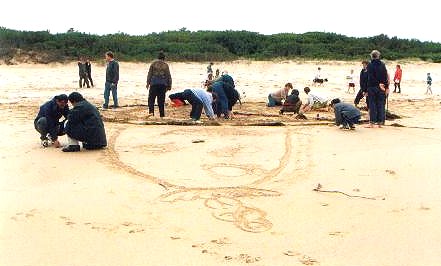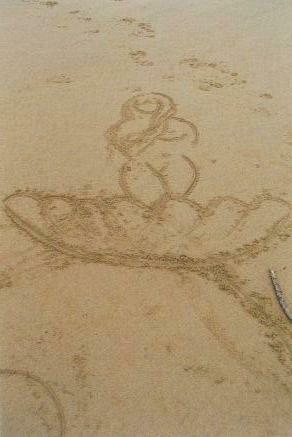|
An Ecopsychological Methodology of Place
|
|
This article is inspired from the beach near my home. I wrote about this place in the last issue of Gatherings (Nov. 2000). As I was in the midst of working through the methodology for my thesis, I looked down at my feet and noticed the intertidal zone, the place where the sea meets the shore. And this movement of water became the inspiration for my research methodology.
I read several different perspectives about alternative research methods and although they talked about the cross-over between subject-object, research-researcher, theory-practice, they seemed inappropriate for an ecopsychological approach. So when I looked beneath my feet and noticed the natural world, I also found a metaphor for research process grounded in relationship. Pioneer environmentalist Rachel Carson (1965, 1998:1) describes this meeting place of sea and land as "strange and beautiful". The shore is an ancient world, for as long as there has been an earth and sea there has been this place of the meeting of land and water. Yet it is a world that keeps alive the sense of continuing creation and of the relentless drive of life. Each time that I enter it, I gain some new awareness of its beauty and its deeper meanings, sensing that intricate fabric of life by which one creature is linked to another, and each with its surroundings (Carson, ibid.:2). The shore line, the place of tidal flows is a place of interconnecting waters; a boundary place that is sometimes land, sometimes sea; a place which is neither sea nor land, or perhaps both sea and land, where my feet sink into the soft, wet sand, where crabs scuttle to hide under rocks and where I drift with the sound of waves lapping on the shore. For Carson, this is an "enchanted place", a "magical zone", a place invested with hidden meaning.
This place engages all my senses and with the wind whistling around me and the salt spray sticking to my skin, I fall into the subtle rhythms of the moon and the earth. In the natural world, places where diverse ecosystems come together are known as ëecotonesí. According to Shulman (1993:234), 'an ecotone is an environmental edge where two systems meet. It is here at the edge that species stretch their limits and extend their range, creating entirely new forms'. This is also my intention in devising an earth-based methodology. The ecotone is the edge place where differences come together, where boundaries drop away, where mutual interaction is inevitable. As metaphor, the ecotone reflects the meeting place of personal experience as told in story - my own and that of the nature carers - and theoretical discourse. Krall (1994:4) describes the ecotone as 'the richest of habitats'. The suburb where I live was once a marshland, a place of interchange between fresh and salt water, considered ecologically as one of the most productive places on earth 'in terms of fecundity and diversity of species' (Krall, 1994:4). The place that was once teeming with life is now filled in and built on, but beneath the ëtamedí culturescape lurks a wild naturescape where waterbirds still wade, and where sometimes, I see a lone Aboriginal man glide past me in his dugout canoe.
This edge place is an in-between space, where visions are real, where time is fluid and boundaries seamless. The tidal place where water ebbs and flows, where the incoming outgoing movement on the beach is linked to the movement of tides across the globe, to the pull of the moon, to the dance in the body, to the flow of thoughts, feelings, dreams, where personal stories flow into an ocean of stories of nature connecting.
Being an edge place, we can experiment with the feelings it evokes. It is not wilderness here but even in the tame, domesticated and constructed beach near my home, with the noisy peak hour traffic close by and the sight of brown haze spreading across the city of Melbourne and the high rise city in the distance, there are possibilities to shift realities, to find new ways of seeing. As I run past the joggers and people meditating on the beach, the outside world falls away and I tune into the gentle lapping of the water, watching the swell of the tides, and feeling the pull in my body. When Neo-Pagans chant: ëWe are the flow and we are the ebb, we are the weavers, we are the webí, they are recognizing this pull of the moon, the flow of tides, and the sacred interconnection with all life.
An ecopsychological research approach then is one of inclusiveness and interconnection. It emerges directly out of personal experience and is embedded in theoretical discourse. The image of the intertidal zone is a reflection of possibilities where different ways of knowing flow together. It is a methodology of relationship.
REFERENCES
|
 One of the underlying themes of ecopsychology is the deconstruction of dualistic forms of consciousness, so I was interested to find a methodology which incorporates the analytical and the experiential as well as the theoretical. I also wanted to find a practice that recognizes the desire to be in the experience as well as commenting on it. And it was important to me to find a methodology which is grounded in the natural world, within an ecological framework that recognizes that everything is connected to everything else.
One of the underlying themes of ecopsychology is the deconstruction of dualistic forms of consciousness, so I was interested to find a methodology which incorporates the analytical and the experiential as well as the theoretical. I also wanted to find a practice that recognizes the desire to be in the experience as well as commenting on it. And it was important to me to find a methodology which is grounded in the natural world, within an ecological framework that recognizes that everything is connected to everything else.
 Underlying the beauty of the spectacle there is meaning and significance. It is the elusiveness of the meaning that haunts us, that sends us again and again into the natural world where the key to the riddle is hidden. (ibid.:7).
Underlying the beauty of the spectacle there is meaning and significance. It is the elusiveness of the meaning that haunts us, that sends us again and again into the natural world where the key to the riddle is hidden. (ibid.:7).

